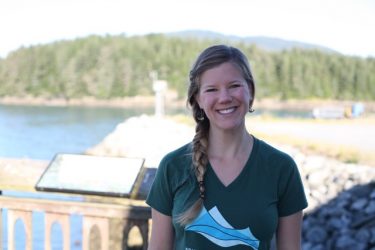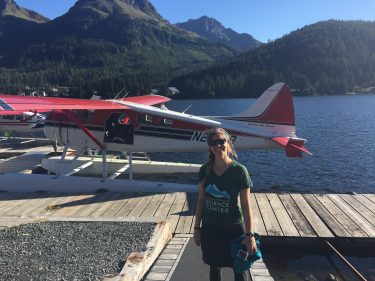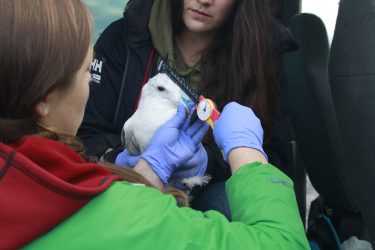
In a plane flying over Alaska’s stunning Prince William Sound, the pilot and crew keep their eyes peeled for schooling groups of herring. The fish are easy to spot from above as they congregate here and there along the shoreline. Each cluster behaves in its own unique way, allowing scientists to tell one group from another.
Amy Brodbeck, a graduate student in the UW College of the Environment’s School of Marine and Environmental Affairs, is among those searching for the fishy cohorts. She has worked elsewhere in Alaska but has never been to the Sound.
“I can’t believe this is my summer job,” she says.

And that wasn’t the only incredible, up-close-and-personal experience she had in her wild Alaskan setting. Working with the Prince William Sound Science Center in Cordova, she joined scientists as they zipped around in boats to measure the water’s salinity, temperature and other ocean parameters. She helped researchers collect seawater samples around the Sound to monitor ocean acidification trends. She spent a little time on land too, hiking with a visiting group of New York City documentary students up a mountainside to view the spectacular Sheridan Glacier.
Brodbeck wasn’t there to do research. As the center’s first science communication intern, she was there to tell stories about the research happening across Prince William Sound.
“We can’t all be experts in science,” she says. “So, I aim to connect scientific research to a broader audience by sharing the stories in a more accessible way.”
Telling that story takes on extra importance in Cordova, where the marine environment is deeply connected to the region’s culture and economy. Prince William Sound was ground zero for a massive 9.2-magnitude earthquake in 1964 and the 1989 Exxon Valdez oil spill. In the wake of these events, the ecosystems fundamentally changed — and so did that human connection.
Those changes persist. Scientists are trying to untangle the effects of those disasters from natural environmental changes and other drivers like climate change. They’re asking why the region’s abundant herring fishery has not yet recovered, a fishery that sustained the income of many fishermen before the oil spill. They’re studying why the sizes of the famous Copper River sockeye salmon have been decreasing, and whether those changes are connected to a changing climate.
Brodbeck dug deep to think about new ways to connect science to the public. She waded in to the world of video, producing three for elementary school students to learn about climate change. After viewing them, enthusiastic kids clamored to discuss how they could help. She also penned articles for the Cordova Times that elevated the voices of scientists and the Center’s work. This was all in addition to keeping the Center’s social media channels and blogs humming along.
When she arrived at the Center, she remembers the positive reception she received from the scientists and education staff.

“With so many things on their plate, they were glad to have someone bring their stories to life in new, creative ways.”
Brodbeck is passionate about helping scientists share their work. When she approached the School of Marine and Environmental Affairs’ Director Terrie Klinger about opportunities for the summer, Klinger knew just who she should talk to: another SMEA alum who is now the president and CEO of the science center. The two put their heads together and discussed the Center’s needs and Brodbeck’s interests, and the science communication internship was born.

Now back in Seattle, Brodbeck is applying her experience to her capstone project. Harmful algal blooms can close commercial fisheries, wreaking havoc on coastal ecosystems and communities. She is working with natural and social scientists at UW and the National Oceanic and Atmospheric Administration to develop better tools for coping with these events. Brodbeck is focusing on communication strategies that will drive home why harmful algal blooms matter to the public and policymakers.
Brodbeck had an immersive, enriching summer, helping her build the professional toolkit to succeed at UW and after graduate school. But her time up north wasn’t all work. In the quiet evening hours, adventures with new friends awaited. She paddled across Lake Eyak and climbed to the other side of the mountain to catch the sunset. She watched the northern lights dance across the night’s sky. She gathered around beach bonfires, met travelers drawn to Alaska for the same spirit of adventure and learning that brings Brodbeck back time and time again.
“There’s something humbling about being surrounded by the giant mountains, glaciers and wilderness areas of Alaska, an experience that reveals what’s really important in life. I feel grateful for the opportunity to work in such a place, while also developing tangible skills that I will carry with me throughout my career.”
Written by: John Meyer, jjmeyer@uw.edu

